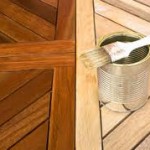Should you paint, seal or stain your deck?

Choosing the right stain for your dek can mean the difference between a great job or a do-over.
As a leading home inspection company in the Buffalo and Western New York area, we have seen our share of decks. In the course of our home inspections, our licensed home inspectors have seen a good number that have been neglected over the years.
A deck in need of routine maintenance is not only unattractive; certain safety hazards may also be presented. That said, it would be to your benefit to properly maintain your deck on an annual basis or as needed. Remember, deferred maintenance is not the same as maintenance free, you simply put off the work and the cost only escalates.
And let’s face it, a new deck is not cheap; the cost can run into the thousands of dollars to build a new one.
As we perform our home inspections, we are often asked if it is better to paint or stain a deck. The answer is: it depends.
In order of effectiveness in coating the deck material, from least to worst, we have listed your options here. However, most effective does not necessarily mean it’s the best choice, read on:
Transparent Stain/Sealer
Transparent stains and sealers are best suited for new installations. They allow the natural grain and appearance of the wood to show through the coating. If you are coating a new deck and like the au naturel look, this should be your choice.
However, the durability of transparent stains/sealers (sometimes called waterproofing sealers) is the least effective and wears more rapidly than other choices. Translation: you will need to recoat more frequently.
Semi-Transparent Stain
A semi-transparent stain has some pigment in the medium. The semi-transparency allows the grain of the wood to show through and therefore give a more natural look while at the same time providing some color.
Semi-transparent deck stains are more suitable to established decks where some weathering has occurred but is in otherwise decent shape.
The semi-transparent stain will be more durable than the transparent stain or sealer and consequently provide more protection to the deck.
Solid Stain
Solid colored stain is fully pigmented and is typically used on older decks where masking coverage is desired. Limited or non-existent grain exposure will result with a solid colored stain.
The solid colored stain is the most durable of the stains, but it also will show wear in traffic areas more readily because of the pigment.
Paint
Paint is a fully pigmented film that can be applied to the deck material. When applied properly, it will provide the best protection of the coatings listed here. However, it also requires more prep work for initial application as well as re-application in subsequent maintenance efforts.
While each coating requires a good deck cleaning prior to application, painting also requires a primer coat and a minimum of 1, possibly 2, finish coats. In re-application efforts, scraping and sanding of peeling or old paint finishes will be required.
Paint is not typically used for deck applications for these reasons.
Oil, Water-borne or Water-based (Latex) Stains
Once you have fully prepared your deck for a new coating and decided which stain to use, you will also need to decide if you want an oil based stain or one that is water-based or water-borne. Water based and water borne stains are not one in the same. Water borne stains actually possess many of the same properties held by oil based stains except clean up can be made with soap and water.
Oil based stains tend to provide the best penetration to the wood grain and therefore the greatest protection. However, if the stain has a pigment or is a solid color, the sun tends to cause more aggressive fading.
Water borne stains are very similar to oil based stains however they dry faster and have a very short re-coat window. Clean up can be made with soap and water.
Water based stains tend to have a more opaque pigment thereby rendering greater protection when using a solid stain. Latex stains dry and cure quickly and there are not usually any restrictions on applying a second coat. Clean up is easy with soap and water.
________________________________________________________________
Lawrence Watkins is a NYS Licensed Home Inspector and the President of Specsure Property Inspections. As a leading full service residential home inspection and commercial property inspection company proudly serving Buffalo, Lewiston, Orchard Park and all of Western New York (WNY) for over 20 years, we are pleased to provide timely and simple DIY tips and hints for today’s homeowner.
For more information you can reach us at 716-881-1914 or via email at info@specsure.com.


